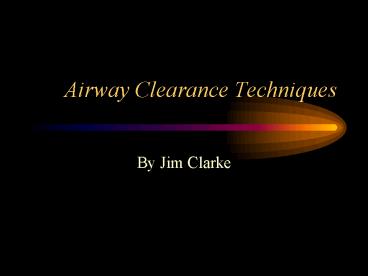Airway Clearance Techniques - PowerPoint PPT Presentation
1 / 24
Title:
Airway Clearance Techniques
Description:
Suctioning - negative pressure applied within the airway. Can be via ET or Trach tube or ... Parts of the Fiberoptic Bronchoscope. Picture from Therapeutic Bronch ... – PowerPoint PPT presentation
Number of Views:475
Avg rating:3.0/5.0
Title: Airway Clearance Techniques
1
Airway Clearance Techniques
- By Jim Clarke
2
Airway Clearance Techniques
- Suctioning - negative pressure applied within the
airway - Can be via ET or Trach tube or
- Through the nose into the trachea
- This is called NT or naso-tracheal suctioning
- Bronchoscopy
- Flexible Fiberoptic bronchoscopy
- Rigid tube bronchoscopy
3
Indications for Suctioning
- Patient has an inability to clear secretions
- Ineffective or absent cough with
- Evidence of retained secretions in upper airway
- A sample of sputum is to be obtained for lab
analysis purposes - Use a sterile sputum trap (Lukens trap)
4
Lukens Trap for Obtained Sputum Sample
5
Contraindications to NT Suctioning
- Absolute contraindication evidence of croup or
epiglottitis - Relative contraindications
- Occluded nasal passages
- Nasal bleeding
- bleeding disorder
- Acute facial, head or neck injury
6
Hazards Complications of NT Suctioning
- Hypoxia/Hypoxemia
- Trauma to nasal passages, pharynx or trachea
- Cardiac or respiratory arrest
- Cardiac dysrhythmias or bradycardia
- Atelectasis
- Bronchospasm
7
When do patients need suctioning?
- Listen over anterior chest with stethoscope
- Evidence of loud rhonchi?
- Does patient have audible crackles when breathing
with their mouth open? - Place hand on anterior chest
- Does patient have tactile fremitus?
- Have patient cough. What is the character of the
cough? Loose but non-productive?
8
Monitoring During Suctioning
- Respiratory rate pattern
- ECG tracing (if available), Heart rate
- Skin color SpO2
- Subjective response
- Sputum character color, consistency, amount and
any odor - Evidence of airway bleeding?
9
Equipment Used During Suctioning
- Suction Regulator attached to wall OR portable
suction unit (see next slide) - Suction canister to collect secretions
- Suction supply tubing
- Suction kit sterile (sheathed or unsheathed)
catheter, sterile gloves basin for irrigation
water sterile water Lubifax or KY Jelly (for NT
suctioning)
10
Suction Regulator
11
Procedure for Suctioning
- Assess need
- Turn on set suction pressure on regulator
- Adults negative 100 - 120 mmHg
- Children negative 80 - 100 mmHg
- Infants negative 60 - 80 mmHg
- Prepare patient Communicate!!!!!!!!!!
- Make sure patient is well oxygenated
12
Suctioning Procedure Continued
- Open necessary sterile saline or water
containers open lubricating jelly containers - Open kit and put glove(s) on
- Lubricate catheter (NT suction only)
- Insert catheter slowly
- Apply suction only while withdrawing using
rotating motion (10-15 seconds only)
13
Suctioning Procedure Continued
- Make sure patient is reoxygenated after catheter
has been removed - Monitor patient and assess need for additional
suctioning - Repeat as necessary based upon need and ability
for patient to tolerate procedure
14
Closed-System Multi-Use ET Catheter
15
Closed-System Multi-Use Trach. Catheter
16
Unsheathed Sterile Catheter
17
Sterile Suction Kit
18
Cath-n-sleeve Catheter
19
Sizes of Catheters
- When suctioning though an ET tube
- Take ET tube size (I.D.) and multiply by 2
- 7.5 mm tube X 2 15
- Next closest size is 14 French
- Mostly commonly used adult size is 14 F
- Largest current adult size is 14 French
- Other smaller sizes are 12F 10F 8F 6F
20
Bronchoscopy
- Therapeutic bronchoscopy
- To visualize and remove mucus from the airway
- Can be used to intubate in situations where
standard intubation techniques have failed - Diagnostic bronchoscopy
- To visualize tumors and obtain tissue samples for
pathology analysis
21
Parts of the Fiberoptic Bronchoscope
22
Picture from Therapeutic Bronch
23
Picture from Diagnostic Bronch
24
THE END!































